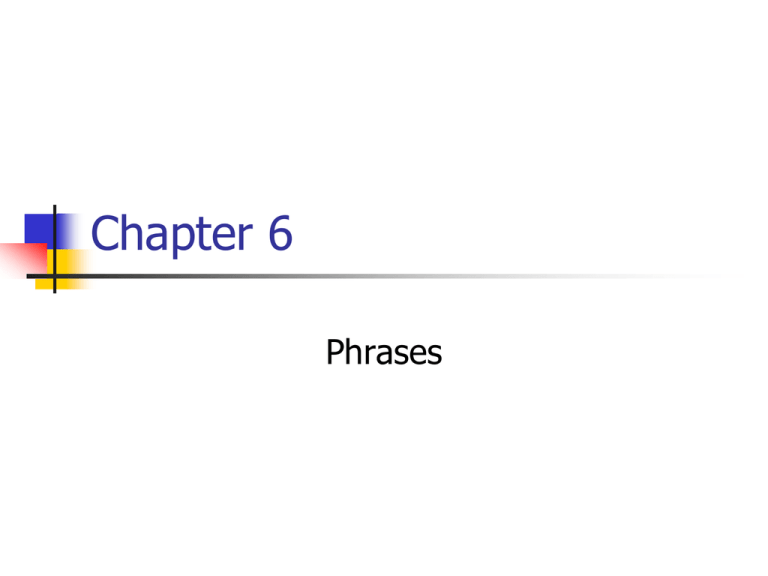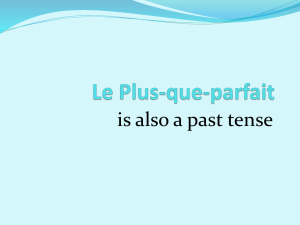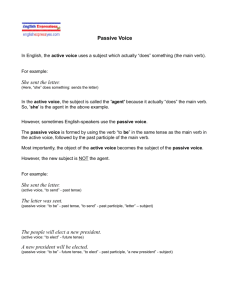Chapter 3
advertisement

Chapter 6
Phrases
Chapter 6: Grammar Safari
Find a ‘real-life’ complex verb phrase
Identify all of the components of the VP
Auxillaries (modal, tense, HAVE, BE) & Main
Draw out the tree to show us how it works
You will need information from the later
parts of the chapter to finish this one…
Example
I would have been going to see the movie.
+ VP tree (to be discussed…)
Subject & Predicate Division?
A
B
The androokers plurked and urkled
beside the broofled lumphet.
D
C
Get Some Exercise
Underline the subjects below
A lion ate an antelope under the tree.
Students have always dreaded tests.
Usually, people find Bill Cosby funny.
Test yourself
Substitute a pronoun for the underlined
section in each sentence above.
Subj / Predicate Division?
Identify Subj/Pred. in the sentences
Use tag, Y/N question or substitution tests
1.
2.
A
B
The trees that covered the mountains
were turning colors: yellow, red & purple.
C
D
Subj / Predicate Division?
Identify Subj/Pred. in the sentences
Use tag, Y/N question or substitution tests
1.
2.
A
B
The test, which I had been dreading for
weeks, turned out to be simple after all.
C
D
Phrase types & Constituency
Constituent
Words that hang together (in Phrases)
Common Phrase Types
NP
VP
ADJP
ADVP
the lamp
might have been turned (on)
(the) red and white polka dot (lamp)
(the lamp shone) extremely brightly
Exercise
Divide and label: NP, MVP, ADJP, ADVP
The mermaids lived under the sea.
They were very happy.
Sailors told mermaid stories to their kids.
Parse the Sentence…
Subject, Predicate; NP, MVP, ADJP, ADVP (& PP, Rel.P)
It suddenly occurred to Bob that the origin of
life debate might run longer than expected.
Reinforcing the inflections reviewed in Chpt 3…
Overview
- Principle Verbal Inflections
Base form {-∞}
Simple Present Tense {-s}
‘BEFORE’
Progressive Form {-ing}
‘NOW’ (Prototypically)
Simple Past Tense {-ed}
Follows “to” or “MODAL”
No ‘time’ implications
‘ONGOING’ (AKA Pres. Participle)
Participle Form {-en}
‘COMPLETED (AKA Past Participle)
@ UNKNOWN TIME’
Work It Out…
• Ignore book’s directions.
• Answer questions below
using the exercise sentences
Exercise 6.4 Page 165
Answer these questions:
1.
2.
3.
4.
What verb form follows BE?
What verb form follows HAVE?
What verb form follows a modal?
Which verb (or helping verb) shows tense?
1st, 2nd, or 3rd…
5.
6.
see previous
slide…
NOTE: “Tense” in the ‘formal’ sense…
What’s funky about tense with a modal?
In what order do AUX verbs appear?
1st, 2nd, 3rd…
Base form {-∞}
It might _____ (something/good/well).
She wants to _____ (something/good).
(find 1 below)
Simple Present Tense {-s}
He _____ (something/good/well) sometimes.
Simple Present Tense?
Looks like the
“Dissolve” transition
in my presentation
needs adjusting
How many present
tense verbs?
1
B. 2
C. 3
D. 4
A.
Simple Past Tense {-ed}
He _____ (something/good/well) then.
Simple Past Tense?
The boy below is a space alien who traded places with Calvin…
How many
“pasts”?
A. 1
B. 2
C. 3
D. 4
Progressive Form [be + -ing]
(AKA Present Participle Aspect)
They are _____ (something/good/well) now.
Progressive?
How many “progressives”?
A. 1
B. 2
C. 3
D. 4
Participle Form
[have + -en]
(AKA Present Participle Aspect)
We have [always] _____ (something/good/well).
Participial?
Chuck should never
have tried to teach
Chester to drive.
How many “participles”?
A. 1
B. 2
C. 3
D. 4
How many BASE verbs?
A= 1, B = 2, C = 3, D = 4
How many “Simple Presents”?
A= 5, B = 6, C = 7, D = 8
How many “Simple Pasts”?
A= 5, B = 6, C = 7, D = 8
How many “Progressives”?
A= 1, B = 2, C = 3, D = 4
How many “Participles”?
A= 0, B = 1, C = 2, D = 3
Any Questions…
…before we move on?
Auxiliary Verbs
AKA “helping Verbs”
HAVE
BE
DO
Modals
}
May also be ‘MAIN’ verbs
Never ‘true verb’
CAN, WILL, SHALL, MAY, Must, Ought
Identify the AUX & MAIN Verbs
Did someone say we should be leaving?
I have been wanting to leave since 8:30.
This must be the longest party of the year.
Our host will not do this again.
NOTE: Each clause has its own verbs…
For more practice look at Exercise 5.4
Remember the Rules?
-ing form comes after BE
-en form comes after HAVE
∞ (base) form comes after a Modal
1st verb in the MVP shows the tense
Modals’ tense ≠ time information
Order of optional Auxiliaries:
1.
2.
3.
(Modal+ -∞)
(HAVE + -en)
(BE + -ing)
Main Verb Phrase Structure
MVP
AUX
TENSE (Modal+[∞]) (HAVE + [-en])
(past or
present)
(Participle)
MV
(BE + [-ing])
(Progressive)
Putting the Tree to Work…
Past + Drive
MVP
AUX
TENSE (Modal+[∞]) (HAVE + [-en])
(past or
present)
(Participle)
Past
MV
(BE + [-ing])
(Progressive)
Drive
Drove
Putting the Tree to Work…
MVP
Past + HAVE + -en + drive
Past + BE + -ing + drive
Past + SHALL + BE + -ing + drive
AUX
TENSE (Modal+[∞])(HAVE + [-en])
(past or
present)
(Participle)
MV
(BE + (-ing])
(Progressive)
Parse
the
Verb
Phrase
Hints:
‘Never’ is
movable…
Chuck should never have tried
to teach his dog to drive.
Infinitives
masquerade
as other
parts of
speech…
Get Some Exercise
(6.5)
Write the following as normal English sentences:
I + past + come + to class today
Concerned students + pres + will + BE + [-ing] + study
Jo + past + Shall +[∞] + HAVE + [-en] + BE +[-ing] + eat
Get Some MORE Exercise
(6.7)
Make sentences using the verb parts:
Tense Modal+∞ HAVE+en
BE+ing
MV
B+ing study
Joe
past
will
----
Joe
pres
----
H+en
----
eat
Joe
past
may
H+en
B+ing
talk
Get Some Exercise
(6.6)
Identify the verb parts:
Tense, Modal {+∞}, Have {+en}, BE {+ing}, Main Verb
All of the runners finished the race.
Fred is being friendly.
George should have been watching TV.
How many verbal elements?
How many “elements” inside the box?
A. 1
B. 2
C. 3
D. 4
Think about the Tense…
After this we research for more
information to go with what we already
knew…
Any errors?
Any suggestions for revision?
1. Find the Error
2. Explain it
3. Fix it
Error Safari
1.
2.
3.
4.
The Picture Exchange Communication
System is useful to start language skills
as well as providing those students
who not talk a way of communication.
Where is the error? – Choose the line #
A. 1
B. 2
C. 3
D. 4
Any Questions…
…before we move on?
Passive Voice…
Takes an Object
makes it a Subject
Called “voice” -- acts like ‘formal tense’
Rhetorical purpose…
Confusability…
Dave’s take…
See pages 242 ff..
Oldest tree in Versailles pulled
down after 324 years
Wed Feb 9,11:28 AM ET Science - AFP
VERSAILLES, France (AFP) - The oldest
tree in the grounds of the palace of
Versailles -- Marie-Antoinette's oak -was pulled down more than 320 years
after it was planted.
Same Idea – Different Focus
Marie Antoinette's
oak was cut down
by a groundskeeper
A groundskeeper
cut down MarieAntoinette's oak
Form 1
Form 2
Meaning 1
The tree is gone
MVP Structure w/Passive
MVP
AUX
TENSE
(Past or
Present)
(Modal+[-∞]) (HAVE + [-en])
(Participle)
(BE +[-ing])
(Progressive)
MV
(BE +[-en])
(Passive)
Active Passive Steps
1.
2.
3.
The original D.O. becomes the subject
BE + en is added to the verb (also “GET + en”)
The original Subj is placed in a BY phrase
*** Optional ***
boys
ate | pizza
pizza
was eaten
boys
Passive Tree – Part I
+ BY
S
NP
VP
NP
Art
N
The boys
V
Art
ate the
N
pizza
Passive Tree – Part II
S
NP
VP
NP
Art
N
Aux MV
The pizza was eaten
X
Optional
BY phrase
goes here…
Passive
BE + -en
OR
GET + -en
Descriptive Passive Rules
1.
2.
3.
4.
5.
A verb with no auxiliary is active
When the main verb ends in
–ing, it must be active
If an –en main verb is preceded by
a form of HAVE, it must be active
If the main verb is not transitive (MV ),
it must be active
If an –en main verb is preceded by
a form of BE (or GET), it is passive
tr
Passive?
1
2
A. 1
B. 2
3
C. 3
D. 4
4
Reasons to use Passive
Don’t know the identity of the subject
Know identity – don’t want to tell
Identity is very obvious from context
Identity isn’t important
Focus on the object/result of an activity
Applying the rules:
Active or Passive?
The ball was thrown by Philip
I finally finished my homework
Amy’s car was stolen during the night
I have eaten too much again
We were studying for the exam
Find the Error
Within these dialects are words that are
acceptable to be spoken, but are not
acceptable to be written.
What has the author done wrong?
What has been done right?
Wrapping It Up
Review Exercises (pg. 190 – 192)
Practical Applications (p. 192 – 193)








